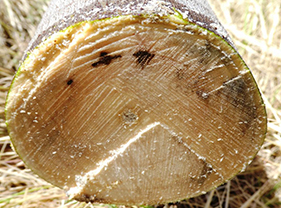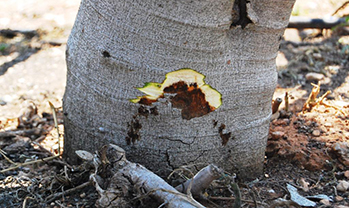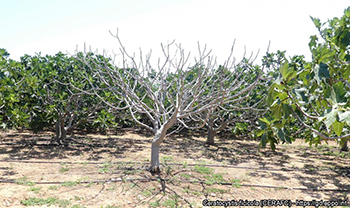
EPPO Alert List – Ceratocystis ficicola
Why
Ceratocystis ficicola was first described in Japan in 2011 causing a serious wilt disease on fig trees (Ficus carica). Disease symptoms had been observed since the 1980s but were initially attributed to C. fimbriata or to a forma specialis, C. fimbriata f. sp. caricae. In 2018, the disease was observed for the first time in Greece in fig trees orchards in Attica and the fungus was also detected on the Euboea Island in 2019. In 2021, disease symptoms and tree mortality were observed in two municipalities near Salento (Puglia) in Italy. In 2022, samples were collected in Sicilia (municipality of Noto) from F. carica showing trunk necrosis. In both cases, the presence of C. ficicola was confirmed in 2023. As C. ficicola can cause mortality to F. carica which is an important cultivated species around the Mediterranean Basin, the EPPO Secretariat considered that this fungus should be added to the EPPO Alert List.

Wood discoloration at the base of the trunk
Courtesy: Panaghiotis Tsopelas

Cankers on Ficus carica 'Vasilika honey-white'
Courtesy: Panaghiotis Tsopelas

Infected Ficus carica 'Vasilika honey-white'
Courtesy: Panaghiotis Tsopelas
Where
Until 2018, C. ficicola had only been reported from Japan where it now affects all fig-producing areas. The recent emergence of this disease in Japan suggests that C. ficicola is an introduced pathogen, but its area of origin is unknown. In 2018, C. ficicola was recorded for the first time in Greece, and the origin of this introduction is also unknown. In 2023, its presence was confirmed in Southern Italy.
EPPO region: Greece, Italy (Puglia, Sicilia).
Asia: Japan (Honshu, Kyushu).
On which plants
In the field, the only known host is F. carica. In inoculation experiments conducted in Greece, it was found that F. benjamina could become infected but was found to be less susceptible than F. carica.
Damage
Affected plants show reduced shoot growth and leaf yellowing, wilting, poor growth of new branches, and eventually die. Brown discoloration can be observed in xylem tissues. In Japan, severe outbreaks have been observed and it is reported that some growers have abandoned their orchards because of the extensive damage caused by C. ficicola. In Greece, severe damage and tree mortality have also been observed.
Dissemination
C. ficicola is thought to be soil-borne, as fig trees planted in contaminated soil easily become infected, and the fungus can be found in the plant rhizosphere. The disease is also spread by infected planting material. In Japan, it has been suggested that an ambrosia beetle Euwallacea interjectus (Coleoptera: Curculionidae: Scolytinae) might be a vector. However, recent studies concluded that as C. ficicola could not be found in the mycangia of E. interjectus it was not a potential vector; although this insect is probably able to passively transport fungal spores on its exoskeleton which possesses numerous pits and setae. Interestingly, these studies identified a new symbiotic relationship between E. interjectus and Fusarium kuroshium which might also play a role in the disease in Japan.
Pathways
Plants for planting of F. carica, contaminated soil from countries where C. ficicola occurs.
Possible risks
F. carica is widely cultivated for fruit production and ornamental purposes in the EPPO region, and more particularly around the Mediterranean Basin. Once C. ficicola is established within an orchard it is difficult to eradicate it as fungal spores can survive in the soil. In Japan, resistance genes have been found in F. erecta and research is being carried out to produce resistant hybrids. Although there are still uncertainties about the biology and epidemiology of C. ficicola, this fungus can cause tree mortality and it is desirable to prevent its further spread in the EPPO region.
Sources
Crous PW, Akulov A, Balashov S, Boers J, Braun U, Castillo J, Delgado MA, Denman S, Erhard A, Gusella G, Jurjević Ž, Kruse J, Malloch DW, Osieck ER, Polizzi G, Schumacher RK, Slootweg E, Starink-Willemse M, van Iperen AL, Verkley GJM, Groenewald JZ (2023) New and Interesting Fungi. 6. Fungal Systematics and Evolution 11, 109–156. https://doi/org/10.3114/fuse.2023.11.09
Habib W, Carlucci M, Manco L, Altamura G, Delle Donne AG, Nigro F (2023) First report of Ceratocystis ficicola causing wilt disease on common fig (Ficus carica) in Italy. Plant Disease (early view). https://doi.org/10.1094/PDIS-03-23-0464-PDN
Jiang ZR, Masuya H, Kajimura H (2021) Novel symbiotic association between Euwallacea ambrosia beetle and Fusarium fungus on fig trees in Japan. Frontiers in Microbiology 12, 725210. https://doi.org/10.3389/fmicb.2021.725210
Kajii C, Morita T, Jikumaru S, Kajimura H, Yamaoka Y, Kuroda K (2013) Xylem dysfunction in Ficus carica infected with wilt fungus Ceratocystis ficicola and the role of the vector beetle Euwallacea interjectus. International Association of Wood Anatomists Journal 34, 301–312. https://doi.org/10.1163/22941932-00000025
Kajitani Y, Masuya H (2011) Ceratocystis ficicola sp. nov., a causal fungus of fig canker in Japan. Mycoscience 52, 349–353.
Morita T, Jikumaru S, Kuroda K (2016) Disease development in Ficus carica plants after inoculation with Ceratocystis ficicola. (1) Relationship between xylem dysfunction and wilt symptoms. Japanese Journal of Phytopathology 82, 301–309 (In Japanese with English summary). https://doi.org/10.3186/jjphytopath.82.301
Shirasawa K, Yakushiji H, Nishimura R, Morita T, Jikumaru S, Ikegami H, Toyoda A, Hirakawa H, Isobe S (2020) The Ficus erecta genome aids Ceratocystis canker resistance breeding in common fig (F. carica). The Plant Journal 102,
Sumida S, Kajii C, Morita T, Kuroda K (2016) Disease development in Ficus carica seedlings after inoculation with Ceratocystis ficicola. (2) Microscopic analysis of the host-pathogen interaction and internal symptoms. Japanese Journal of Phytopathology 82, 310–317 (In Japanese with English summary). https://doi.org/10.3186/jjphytopath.82.310
Tsopelas P, Soulioti N, Wingfield MJ, Barnes I, Marincowitz S, Tjamos EC, Paplomatas EJ (2021) Ceratocystis ficicola causing a serious disease of Ficus carica in Greece. Phytopathologia Mediterranea 60(2), 337-349. https://doi.org/10.36253/phyto-12794
Yakushiji H, Morita T, Jikumaru S (2019) Ceratocystis canker resistance in BC1 populations of interspecific hybridization of fig (Ficus carica) and F. erecta. Scientia Horticulturae 252, 71-76 (abst.).
EPPO RS
